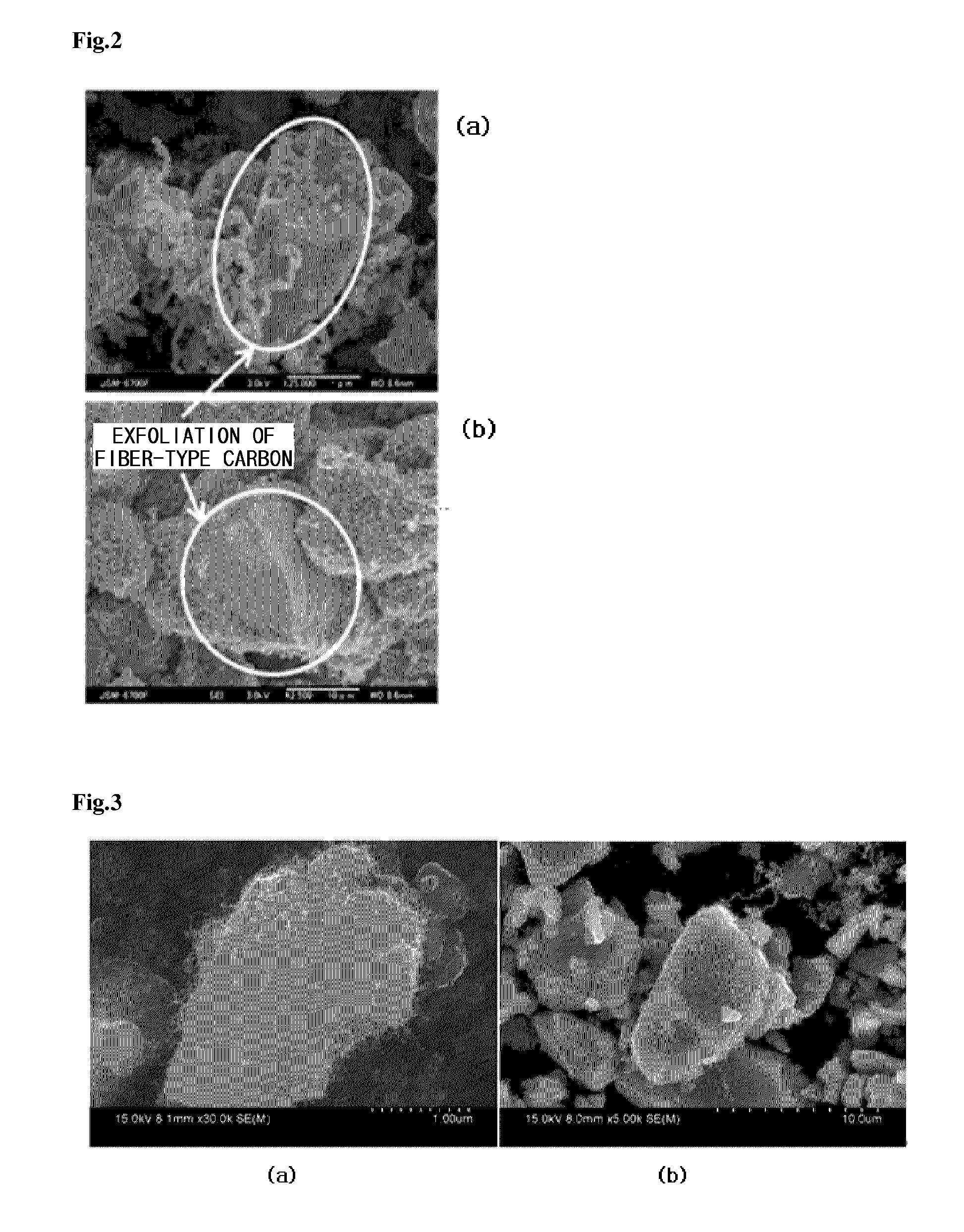Anode active material for lithium secondary battery, method of preparing the same, and lithium secondary battery including the anode active material
a lithium secondary battery and anode active material technology, applied in the direction of electrode manufacturing process, cell components, coatings, etc., can solve the problems of low capacity per unit mass of graphite, volume expansion and contraction, and difficulty in preparing high-capacity lithium secondary batteries using graphite, so as to improve the performance of the battery, the effect of improving the conductivity
- Summary
- Abstract
- Description
- Claims
- Application Information
AI Technical Summary
Benefits of technology
Problems solved by technology
Method used
Image
Examples
example 1
[0058]SiO (average particle diameter of 4 μm to 7 μm) was added to Fe(NO3).6H2O. Subsequently, the mixture thus obtained was dried and then heat treated to disperse a Fe catalyst on surfaces of silicon oxide particles.
[0059]The silicon oxide particles having the Fe catalyst dispersed on the surfaces thereof were put in a chemical vapor deposition (CVD) chamber and a composite was then obtained by growing carbon nanofibers on the silicon oxide particles while argon (Ar) gas was supplied for five minutes and a predetermined amount of ethylene (C2H4) gas was then supplied at a temperature of about 900° C.
[0060]An amount of the grown carbon nanofibers was about 5 parts by weight based on 100 parts by weight of the silicon oxide particles. It was observed that the prepared carbon nanofibers were non-uniform and had a diameter of 20 nm to 200 nm.
[0061]In order to remove the Fe catalyst impregnated in the composite thus prepared, the composite was immersed in a 10% hydrochloric acid soluti...
example 2
[0064]The anode active material prepared in Example 1, a styrene-butadiene rubber (SBR) as a binder, carboxymethyl cellulose (CMC) as a thickener, and acetylene black as a conductive agent were mixed at a weight ratio of 95:2:2:1 and the mixture thus obtained was mixed with water (H2O) as a solvent to prepare a uniform anode slurry. One surface of a copper current collector was coated with the prepared anode slurry to a thickness of 65 μm, dried and rolled. Then an anode was prepared by punching into a predetermined size.
[0065]Ethylene carbonate (EC) and diethyl carbonate (DEC) were mixed at a volume ratio of 30:70, and LiPF6 was added to the non-aqueous electrolyte solvent thus prepared to prepare a 1 M LiPF6 non-aqueous electrolyte solution.
[0066]Also, a lithium foil was used as a counter electrode, i.e. a cathode, a polyolefin separator was disposed between both electrodes, and a coin-type lithium secondary battery was then prepared by injecting the electrolyte solution.
experimental example 1
[0068]
[0069]A surface of an anode of the lithium secondary battery of Comparative Example 2, in which the anode active material prepared in Comparative Example 1 was used, was identified by SEM images and the results thereof are presented in FIG. 2. FIGS. 2(a) and 2(b) were SEM images at high magnification and low magnification, respectively.
[0070]As illustrated in FIG. 2, in a case where a carbon coating layer was not formed on the surfaces of silicon oxide particles and carbon nanofibers grown on the silicon oxide particles as in Comparative Example 2, it may be confirmed that the carbon nanofibers almost did not remain because the carbon nanofibers were exfoliated from the silicon oxide particles.
[0071]That is, in a case where the anode active material of Comparative Example 1 was used, it may be understood that fiber-type carbon was exfoliated from the silicon oxide particles during the preparation of the anode slurry or the operation of the battery.
[0072]
[0073]A surface of an a...
PUM
| Property | Measurement | Unit |
|---|---|---|
| length | aaaaa | aaaaa |
| diameter | aaaaa | aaaaa |
| particle diameter | aaaaa | aaaaa |
Abstract
Description
Claims
Application Information
 Login to View More
Login to View More - R&D
- Intellectual Property
- Life Sciences
- Materials
- Tech Scout
- Unparalleled Data Quality
- Higher Quality Content
- 60% Fewer Hallucinations
Browse by: Latest US Patents, China's latest patents, Technical Efficacy Thesaurus, Application Domain, Technology Topic, Popular Technical Reports.
© 2025 PatSnap. All rights reserved.Legal|Privacy policy|Modern Slavery Act Transparency Statement|Sitemap|About US| Contact US: help@patsnap.com



